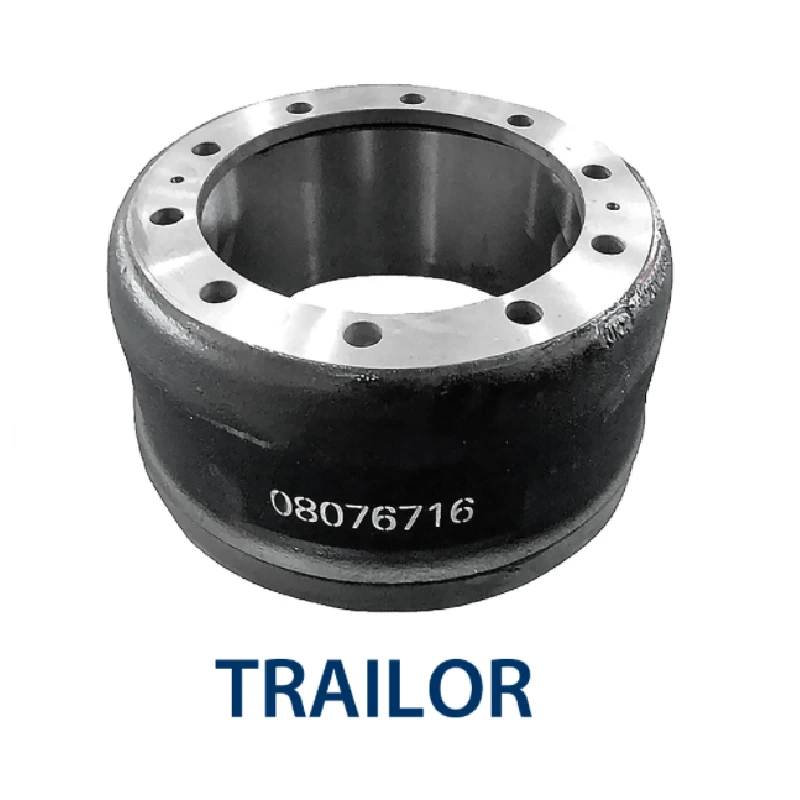ທ.ວ. . 07, 2024 05:54 Back to list
brake drums and rotors
Understanding Brake Drums and Rotors Their Importance and Functionality
When it comes to vehicle safety and performance, the braking system is one of the most critical components. Among the various parts that constitute this system, brake drums and rotors play pivotal roles. Though both serve the same primary function of slowing down or stopping the vehicle, they do so in different ways and are designed for different types of vehicles and driving situations. Understanding brake drums and rotors can help you appreciate their importance in automotive safety and maintenance.
What Are Brake Drums and Rotors?
Brake drums are typically used in older vehicles or in the rear braking systems of some modern cars. They are cylindrical components that house the brake shoes. When the driver presses the brake pedal, hydraulic pressure forces the brake shoes outward against the inner surface of the drum, creating friction that slows down the wheel’s rotation. This type of system is effective for delivering the necessary stopping power, especially in lighter vehicles.
On the other hand, brake rotors—also known as discs—are more commonly found in modern vehicles, especially in the front braking systems. A rotor is a flat, disc-shaped component that is mounted to the wheel hub. When the brakes are applied, brake pads compress against the rotor’s surface, generating friction that reduces the speed of the wheel. This design tends to dissipate heat more effectively than drum systems, making it preferable for high-performance situations and heavier vehicles.
The Differences Between Drum and Disc Brakes
The fundamental difference between drum and disc brakes lies in their construction and the way they generate friction. Drum brakes are enclosed systems, which can sometimes lead to overheating and reduced performance in high-stress situations, such as heavy braking. Disc brakes, however, are open and allow for better ventilation, which helps to manage heat buildup.
Another key distinction is maintenance. Drum brakes can be more complicated to service because they have multiple components that may wear out, such as the springs and adjusters. Disc brakes generally have a simpler design—most repairs only involve replacing worn-out brake pads and resurfacing the rotors when necessary.
brake drums and rotors

Performance Considerations
When selecting a braking system, vehicle manufacturers often consider performance expectations. Disc brakes are typically favored for high-performance applications, as they provide better stopping power and heat management. This is crucial for sports cars or vehicles that frequently tow heavy loads.
Conversely, drum brakes may still be suitable for certain applications, such as rear brakes in economy cars. They are often less expensive and may provide adequate performance for light-duty driving. However, as automotive technology continues to evolve, many manufacturers are phasing out drum brakes in favor of more efficient disc systems.
Importance of Regular Maintenance
Regardless of whether your vehicle has drum brakes, disc brakes, or a combination of both, regular maintenance is essential for ensuring optimal performance. This includes routine inspections, timely brake pad and rotor replacements, and addressing any signs of wear or malfunction. Symptoms like grinding noises, vibrations during braking, or a spongy brake pedal may indicate problems within the braking system that need to be addressed immediately.
Moreover, understanding the differences between brake drums and rotors can help car owners make informed decisions about their vehicle's maintenance needs. While the braking system's primary function is to provide safety, its efficiency and responsiveness rely on the condition of these critical components.
Conclusion
In summary, brake drums and rotors are integral to a vehicle's braking system, each with its own set of advantages and disadvantages. While disc brakes have become the standard for many modern vehicles due to their performance capabilities, drum brakes still serve a purpose in specific contexts. Regular maintenance and timely replacements of these components can ensure that your vehicle remains safe on the road. Understanding the mechanics of your braking system is not only beneficial for optimal performance but also essential for driving with confidence.
-
Volvo Brake Drum: OEM Quality, Optimal Safety
NewsAug.27,2025
-
Durable Brake Drum MAZ for Heavy Duty Trucks | High Performance
NewsAug.26,2025
-
FUWA: Premium Quality, Reliable Performance & Innovative Solutions
NewsAug.25,2025
-
Liza Brake Drum: Superior Quality & Performance for Safe Driving
NewsAug.24,2025
-
Iveco Brake Drum | Premium OE Quality for Daily & Eurocargo
NewsAug.22,2025
-
Your Brake Drum Man: Quality & Performance Parts
NewsAug.21,2025
